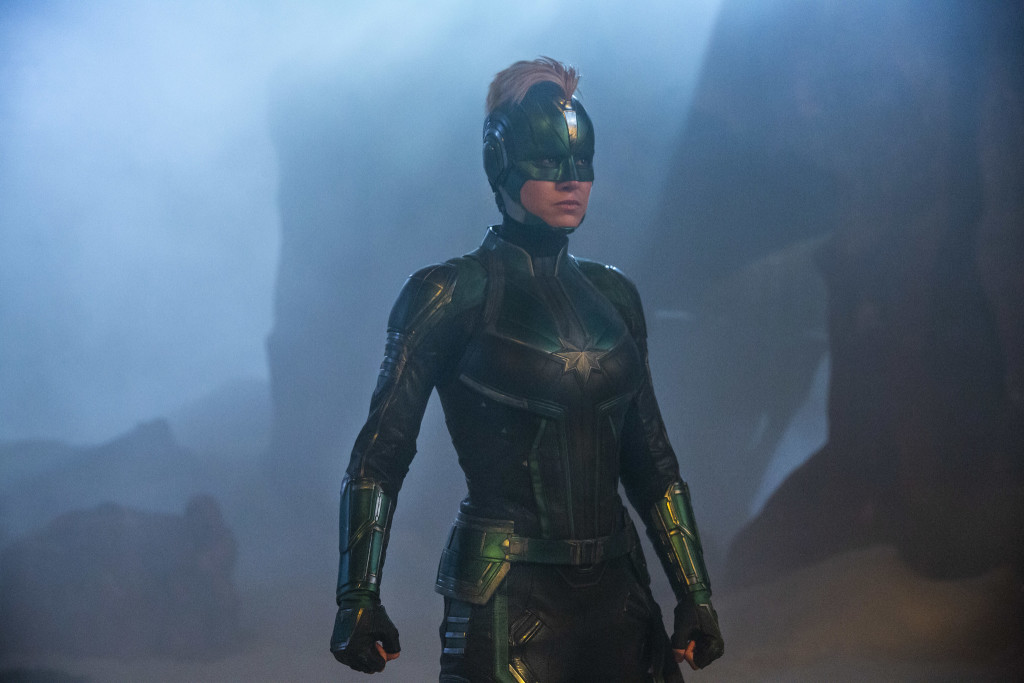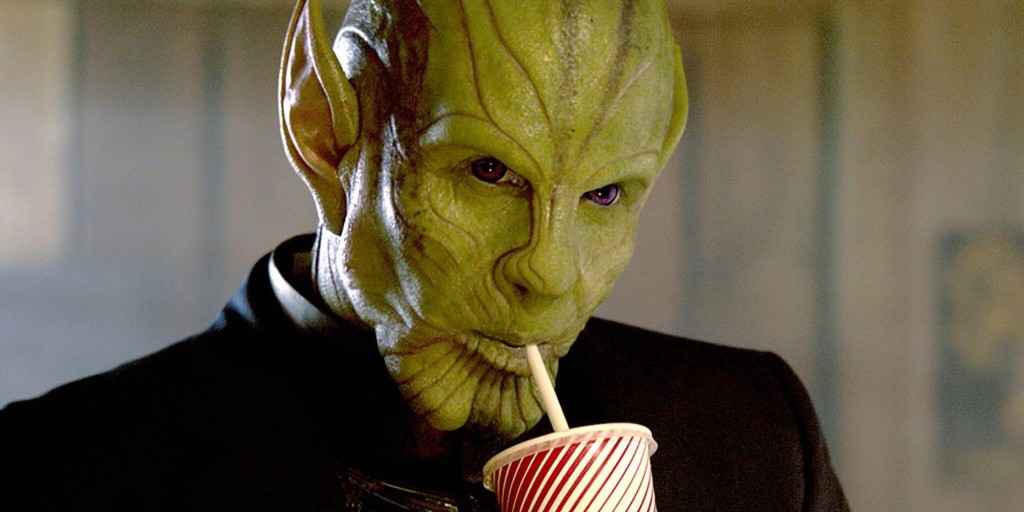Genre: Superhero
Premise: (from IMDB) Carol Danvers becomes one of the universe’s most powerful heroes when Earth is caught in the middle of a galactic war between two alien races.
About: There was a lot of uncertainty about how much money Captain Marvel would make this weekend, with estimates ranging anywhere fro 80 million to 150 million. By pulling in 152 million dollars, Disney and Marvel have to be stoked. They’ve got another huge hit on their hands. I have one little nitpick here about the writing credits. Why did the directors have to take a credit? I mean come on already. You’ve got the most desired credit in the business – a directing credit. Why take the writing credit as well? That always annoys me. It just feels greedy.
Writers: Story by Nicole Perlman & Meg LeFauve and Anna Boden & Ryan Fleck & Geneva Robertson-Dworet – Screenplay by Anna Boden & Ryan Fleck & Geneva Robertson-Dworet
Details: 2 hours 4 minutes
CAP-TAAAAAAIN MARRR-VEEELLLLLLLLLLL
It’s here!
The first real movie of 2019. And it showed us that audiences are still willing to pony up cash to go to the movies.
But only if that movie has a Marvel logo in front of it.
It’s getting scary folks. I used to think audiences would tire of superhero movies. But it seems like they’re the only movies people actually pay to see anymore.
For those of you who read my newsletter, you saw that I wasn’t looking forward to this film. Personally, I didn’t think the writing or directing talent were up to snuff for a blockbuster movie. But I wouldn’t mind being proven wrong. Let’s see if I was.
If I don’t place today’s plot breakdown in the Dumbed Down Machine my head might explode. So here goes. Vers (Brie Larson) is a Kree, an alien race in the far reaches of somewhere. Vers is given a mission to go to earth to locate a lightspeed prototype for her people. But when she lands on earth (circa 1996), she starts having flashbacks of a life here. It’s confusing, but she tries to keep the focus on her mission, which teams her up with a human named Nick Fury (Samuel Jackson).
That mission is complicated when aliens called Skrulls, who have the power to shape-shift into humans, arrive on the planet, searching for the same thing. The race is on, and eventually the leader of the Skrull team, Talos, catches up to them and, to our surprise, politely asks if he can join them. Hmm, maybe these Skrulls aren’t such bad dudes after all. Even if they do look like rejected concept art from Star Trek. This new super team of Krees, Skrulls, and humans, finally find the hyper drive. But before they can secure it, an evil fourth race arrives to both take the drive and blow up earth. It will be up to Vers, aka Carol Danvers, aka Captain Marvel, to stop them!
If you forced me to distill my screenwriting advice down to a single sentence, it would be this: Keep it simple. The further you go away from simple, the more problems you’re going to have. The writers of Captain Marvel obviously don’t read this site. Cause they took the Captain Marvel screenplay in the most complex direction they possibly could.
First of all, you have this alien woman going to earth to retrieve something for her people. While she’s on earth, she starts having memories of living on earth. This is the story’s central mystery. Why does Captain Marvel have memories from earth if she’s an alien? It doesn’t take long for us to figure that out. She must have been a human at one point. This means the mystery is downgraded to the less explosive question, “How did Vers become an alien if she was once a human?” Mileage may vary on who finds that question compelling but I’m guessing most audience members don’t care.
To understand how strange this choice is, imagine the more traditional version of this story. We meet Carol Danvers AS A HUMAN BEING on PLANET EARTH. We get to know her and see her day to day activities. During this time, she’s having memories of living on an alien planet. The mystery then becomes more straightforward: Why is a human having memories of being an alien? This would have been a much simpler story to tell.
So I don’t understand why they flipped it in a way that made everything so discombobulated. We’re following someone who looks human but who’s an alien who remembers being human who turns out to be both. Not only do I find that uninteresting, but it makes writing your screenplay a nightmare. All your energy has to be put into filling in the 10,000 plot holes that inevitably pop up when you write something this complicated.
Let me ask you a question. What are the best Marvel movies so far? I would say, in no particular order: Deadpool, Spider-Man: Homecoming, Winter Soldier, and Iron Man (I would personally place Ant-Man in there as well). And a big reason why all those movies worked is because the screenplays were so simple. No screenwriting pyrotechnics were involved. Captain Marvel’s biggest issue is that it spends its first 50 minutes fighting an overly-complex lumbering narrative it never should’ve used in the first place. Once it emerges from that nonsense and enters into a clean easy-to-understand story (find the MacGuffin), it gets a million times better. And if that isn’t an endorsement for keeping your plots simple, I don’t know what is.
Another thing that wacky plotting can do to your script is blind you to the stronger elements within it. The strongest element in this screenplay is the Skrulls. One of the best script scenarios is when you have two characters in a scene and one is lying to the other. For example, if two guys are having lunch and one guy is secretly sleeping with the other’s wife. That lie (or secret) permeates the scene, making the interaction interesting.
Well, what’s the ultimate lie, then? That would be when you’re impersonating someone else. That scenario is a screenwriter’s dream because the scenes write themselves. It’s no surprise that one of the best scenes in one of the best movies ever, Die Hard, is when Hans runs into John and pretends to be a hostage. So I don’t know why Captain Marvel didn’t do more with the Skrulls. If you shifted your focus from writing the screenplay equivalent of a mushroom trip to a straight-forward mission where everyone you interacted with could be a potential enemy, the possibilities are endless. John Carpenter proved that 30 years ago with The Thing.
The fact that Captain Marvel emerged from these issues at all is a minor screenwriting miracle. But it does and a big part of that is, ironically, due to the two big male roles in the movie, Nick Fury and Talos (Ben Mendelsohn). This is the first time Fury has really gotten to spread his wings in a Marvel film, and he’s so good at it that you wonder why they didn’t let him do it earlier. Also, Samuel Jackson and Brie Larson have great chemistry together, which helps you forget that Brie isn’t quite right for her role.
But the real star to come out of this is Ben (for those who don’t know, Mendelsohn starred in directors Anna Boden & Ryan Fleck last film, Mississippi Grind). My favorite scene in Captain Marvel is when the group is flying somewhere and they’re quizzing Talos, asking him what he can and can’t transform into. “Can you transform into a cabinet?” someone asks. Mendelsohn has one of the all time great baffled reactions before answering, “Why would I want to transform into a cabinet?” And you know a character is working when they have stellar chemistry with a cat. Speaking of, another one of my favorite moments was when the Skrulls put a Hannibal Lecter mask on Goose the Cat.
(major spoilers) Finally, the big screenwriting win in Captain Marvel was the Skrull storyline. We went into this assuming these things were villains. But the writers cleverly trick us, and reward us with a surprisingly touching climax for Talos and his people. Unfortunately, that caused some problems with who the real villain was. And we get this strange trifecta of villains (Supreme Intelligence, Yon-Rogg, and Ronan) who never quite scare us enough to make us worried. I’ll save my rant about late-revealing villains for another day but I’ll leave you with this: you probably shouldn’t do it.
Despite all its problems, Captain Marvel wins us over because it’s such a charming movie. Marvel is great at this. They understand that as long as you have a good time at a movie, you’ll overlook many of its faults. That’s why DC struggled for awhile with both Superman and Batman vs. Superman. You didn’t leave either of those movies feeling good. But their most recent films, Wonder Woman and Aquaman, were crowd-pleasers. I don’t think that’s an accident.
So there you go! Color me surprised. I didn’t think I’d like this one but I did! What did you think?
[ ] What the hell did I just watch?
[ ] wasn’t for me
[x] worth the price of admission
[ ] impressive
[ ] genius
What I learned: Plot holes. Plot holes are the direct result of how complicated your screenplay is. The more non-traditional and time-jumping and secret-keeping and unknown identities your plot is, the more time you’ll be pulling your hair out, draft after draft, trying to fill in the holes that that kind of plot creates. I’m not saying it can’t be done or that you should only write Taken. Only that you should be prepared to do the work. Cause if you don’t put in the time, all you have is a big messy movie where everyone’s pointing out how many plot holes there are.
What I learned 2: I like storylines where the villains arc from bad to good. It’s usually more touching than a hero transformation if done well. Of course, Talos wasn’t ever “bad” in this movie. But we thought he was. That was enough.




